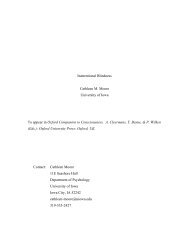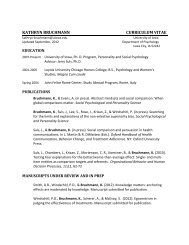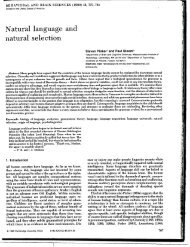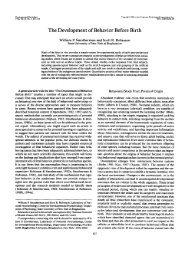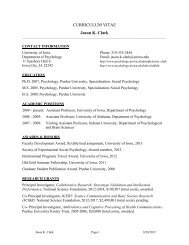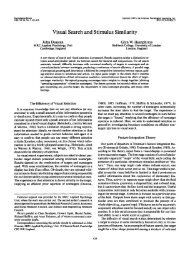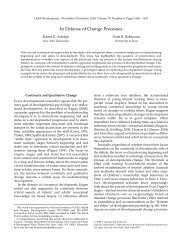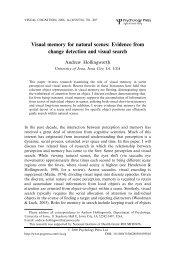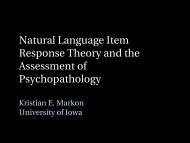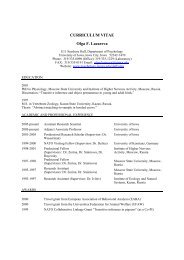Speech and language development following ... - ResearchGate
Speech and language development following ... - ResearchGate
Speech and language development following ... - ResearchGate
- No tags were found...
You also want an ePaper? Increase the reach of your titles
YUMPU automatically turns print PDFs into web optimized ePapers that Google loves.
C. Ouellet, H. Cohen / Journal of Neurolinguistics 12 (1999) 271±288 273Language <strong>development</strong> appears to be based on relatively plastic neural systemsthat are also used for other cognitive <strong>and</strong> perceptual functions [4]. But children<strong>and</strong> adults do not necessarily use the same neural resources for <strong>language</strong>perception <strong>and</strong> production <strong>and</strong> some parts of the brain may be more active incertain kinds of linguistic activities over time. Locke [37] assigns early vocallearning <strong>and</strong> utterance acquisition to the right hemisphere whereas, in oldersubjects, the left hemisphere is dominant for everything related to lexicalcomprehension, expression, syntax <strong>and</strong> grammar tasks. One follow-up study hasshown that the linguistic abilities of a left-hemispherectomized child were similarto those of <strong>language</strong>-impaired children whereas the linguistic competencies of aright-hemispherectomized child resembled those of <strong>language</strong>-normal children [75].In the same way, school-age children with left hemisphere lesions show morediculties with <strong>language</strong> than those with right hemisphere lesions, althoughproblems in <strong>language</strong> <strong>development</strong> may occur in both groups. These resultsprovide indirect support for innate specialization <strong>and</strong> plasticity as well as for theinvolvement of the right hemisphere in <strong>language</strong> acquisition <strong>and</strong> verbal cognition[49].Experience may also in¯uence cerebral organization <strong>and</strong> activity. Dehaene et al.[17] found some anatomical variability in the cortical representation of ®rst <strong>and</strong>second <strong>language</strong>s. Subjects who listened to stories in their ®rst <strong>language</strong> showedactivation of the left temporal lobe, especially in the areas along the left superiortemporal sulcus, whereas those who listened to stories in their second <strong>language</strong>showed activity in varying left <strong>and</strong> right temporal <strong>and</strong> frontal areas, sometimesrestricted to right hemisphere regions.The central auditory system may also experience a functional reorganization<strong>following</strong> changes in auditory stimuli, leading to linguistic improvement [70].Volumetric measurements of the planum temporale, contained in the perisylvianarea, which has been implicated in <strong>language</strong> <strong>development</strong>, have revealed that thisarea is already larger on the left than on the right side in the fetal brain.Following auditory deprivation, which results in inactivation of the neurolinguisticmechanisms, a compensatory hypertrophy of the homologous right hemispherestructures may develop as a result of a general neuromaturational delay. The righthemisphere would then control linguistic parameters that were previously underthe left hemisphere's domination. There is a functional shift to intact brainstructures at that time. According to Locke [37], this adaptive but unusual brainorganization produces a functional but imperfect comm<strong>and</strong> of <strong>language</strong>. Pontonet al. [61] suggest instead that the auditory system does not mature withoutstimulation. They showed that the maturational processes of the cortical auditorysystem, which do not progress during a period of deafness, resume after acousticstimulation is reintroduced. However, Truy et al. [80] found that the ascendingauditory pathways remain operational long after prelingual deafness <strong>and</strong> that theauditory cortex can be activated by electrical stimulations of the cochlea evenwithout perception of environmental sounds. In their study, subjects showedincreased auditory cortex activity during electrical cochlear stimulation.



